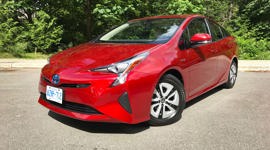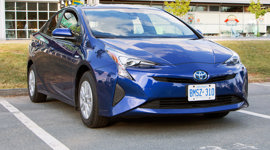Fuji Speedway sits in the shadow of a veiled volcano, a temple filled with the spirits of long-dead racers. In the old days, when aerodynamics was a half-understood alchemy, they'd come off the straightaway at maximum velocity to shoot into the curved embankment, a man-machine marble of steel and bone, muscle and fuel. Many died in glory; some lived in victory.
Sacred ground indeed, but what a very odd place to launch a modestly-powered hybrid.
Like sea urchin sushi, it's an acquired taste from pretty much every angle.
Most enthusiast drivers regard the Prius in the same way a five-star Michelin chef regards a microwave. It's a perfectly functional piece of equipment, but one which you'd rather not use. That's a shame, really, as the original Prius managed to create an entire new segment of vehicle. Over the past 18 years, they've sold an incredible 3.5 million of the cars, nearly all of which have served faithfully and without incident.
Is it exciting to drive? Not really, no, but consider the complexity of the machine and its great success. It works as a taxi. It works as a commuter. It has few drawbacks in terms of passenger space, sips fuel, and even has solid resale. The Prius is a known quantity on the road (if not the racetrack), and here's the new one.
We've had three generations of Prius thus far, each adding a slight element of personality to what essentially appears to be a wheeled Dustbuster. But if the changes had thus far been evolutionary, the fourth-generation Prius takes more of a leap in styling. The nose of the thing extends forwards, like a catfish's pursed lips, and there's an X-shaped silhouette formed by the angular headlights.
Like sea urchin sushi, it's an acquired taste from pretty much every angle. The side-profile attempts to disguise a certain bustle-backed rear with a floating glass C-pillar, and the rear is dominated by long thin vertical taillights – that X-shape again.
However, if it's not exactly pretty, it is at least more daring. There's less tarmac food-processor going on here, and more effort made to differentiate the Prius from the ordinary internal-combustion-engine-powered jellybeans of modern traffic.
Inside, the Prius is obviously doing all it can to get rid of its automotive hairshirt reputation. The old car's innards looked very much like they'd been plucked from your recycling bin, and what with the central gauges and monochrome green display, were more than simply dated. This new car is immediately nicer, though not as conventionally attractive as either Ford or Chevy's hybrid offerings.
It's a bit of a mish-mash. Graphics are improved for all readouts, and a new 7” centre touch screen features the easy-to-use Entune system (a 10-speaker JBL audio system is available for higher grades). The upper portion of the dash remains centrally-located, but it doesn't feel like a cost-saving measure so much as simply trying to appeal to the Prius faithful while offering something fresher looking. There's also significant swathes of white plastic trim, slightly reminiscent of the Kia Soul EV. That's not something you'll find on other Toyota products, and one wonders if its there to leave further room for the Lexus CT to further differentiate itself with a more conventional look. Also annoying is that there's just a single USB plug, and SofTex synthetic leather still feels about as convincing as a cow's wetsuit.
However, in terms of metrics, the Prius remains comfortable and swells in all dimensions. The back seats do have some restricted headroom thanks to the new car's slippery outlook (overall coefficient of drag is down slightly to 0.24), but rear cargo room remains excellent considering room needs to be found for batteries and drivetrain.
Of course, with any Prius, it's not so much beauty in the eye of the beholder as it is under the skin. While previous generation cars have seen upgrades to power output and increased fuel economy, some of the changes made to this new car are quite surprising.
For instance, the cost-effective and space-efficient torsion beam suspension is gone, replaced with a proper double-wishbone setup tuned for handling. Handling? In a Prius?
Further, the Prius is underpinned by a new global platform called Toyota New Generation Architecture (TNGA). It's reportedly 60% stiffer than the outgoing model, so let's get it out on Fuji's short track and see what it can do.
From the spec sheet, the new '16 Prius is most definitely still more David Suzuki than Suzuki litre-bike. Power from the gasoline-electric system is actually down from the previous year, with just 121hp total available. The 1.8L Atkinson cycle combustion engine makes 95hp and 105 lb-ft of torque, and the electric motor – now fed by a lithium-ion battery rather than nickel-hydride – makes 71 hp and 120 lb-ft of torque. Combined torque is down along with horsepower, and total curb weight is up by a few kilograms.
Hardly inspiring stuff, and yet the new Prius feels sprightlier, lighter on its feet. Back-to-back with the fuel-cell Mirai, there's certainly less punch on offer (0-100kms takes about ten seconds), but once it's up and moving the Prius feels much less inclined to roll over and play head. Taking it through a slalom course didn't result in a panicked traction-control system firing off flares and locking down the wheels, and it was even possible to lightly trail-brake the car around one of the tighter right-hand corners.
There are three driving modes to be accessed: Power, Normal, and Eco. If the Mazda MX-5 doesn't need a Sport mode, then the Prius doesn't need an Eco button. Still, the adjustability of throttle and transmission mapping might be handy if you were scaling a mountain pass on a weekend road trip instead of handling the Monday to Friday commute.
Now, I know what you're thinking: by the beard of David Attenborough, who gives a biodegradable wood-fibre damn about whether or not the Prius is more fun to drive than its predecessor? The raison d'être of this thing is fuel economy, fuel economy, fuel economy. To that end, I can merely point you to an expected 4.5L/100kms combined fuel economy (4.7 on the highway, 4.3 in town, figures converted from US specification), and to the innate energy-saving consequences of being able to carry your speed through a corner with confidence.
Those fuel economy figures are a pretty mild improvement over the outgoing car, and the proof of the pudding is in the saving, so to speak. Still, the Prius has done reasonably well in real-world testing before, better than expected, and it should be pointed out that Toyota's hybrid systems are about as well-trusted at this point as their conventional engines. No, you won't make up the premium over a Corolla in fuel savings if you elect to plump for the Prius, but given strong resale for both, the more city commuting you do the better your wallet looks.
Further, the move to lithium-ion battery for everything save the base model Prius will make the introduction of plug-in capabilities easier and hopefully cheaper (the considerable premium paid in the old plug-in Prius was its Achilles' heel). Further, there's very likely an all-wheel-drive variant coming which will please those in slippery climates.
Also, from a safety standpoint, Toyota is also rolling out the Prius with an available self-stopping safety system. Using camera and radar, it's capable of slowing or stopping the car before it hits a pedestrian or rear-ends somebody, and with a technician at the wheel, certainly seemed to work. The track-pants-clad mannequin lurched out in front, the Prius stopped suddenly, all was well. It's a simpler system than those available from Volvo and the like, but will likely be standard on more Toyotas in the future.
Fuji speedway has seen all kinds of racing over the decades, and largely two types of racers have emerged as the most successful: those who take risks, and those who are consistent. The Prius, and Toyota, is most definitely of the latter school; this is no high-speed passing maneuvre.
Rather, recognizing that they're in pole position with a hybridized product that people know, recognize, and understand, Toyota keeps their strategy the same. There is no one single facet of this vehicle that will make you stand up and cheer when compared to the outgoing model. That doesn't mean it isn't a showroom winner.
Pricing
Prius base: $25,995
Prius base w/ upgrade package: $26,585
Prius Touring: $29,330
Prius Technology: $28,730
Prius Technology w/ advanced package: $31,990

































